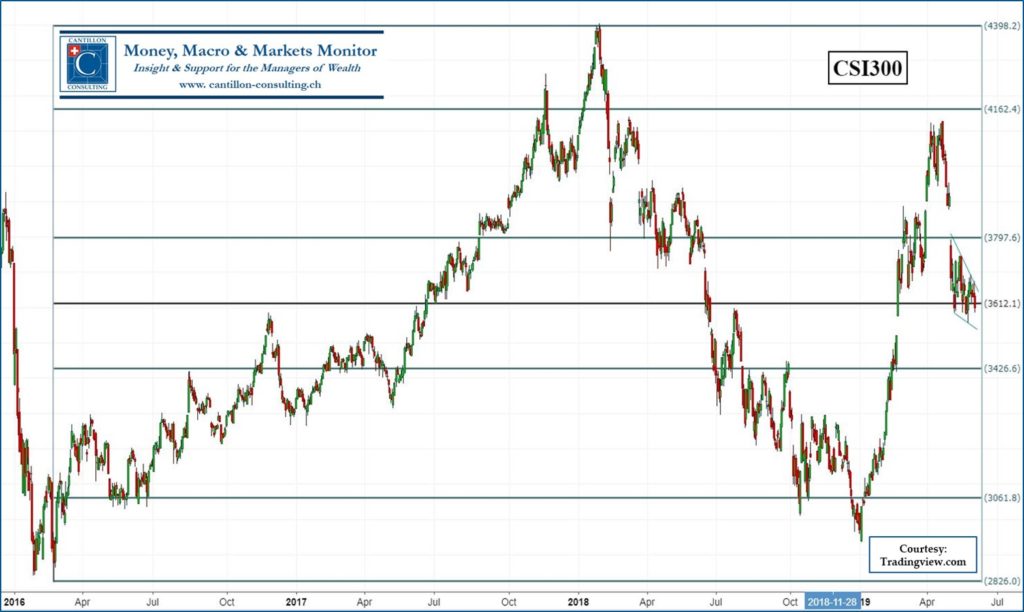Last week, as the Trade War with the US worsened – and as the assault on China’s flagship telecoms company, Huawei, was intensified – President Xi Jinping, accompanied by his chief trade negotiator, Liu He, made a highly symbolic visit to Jiangxi, the starting point of the Communist Party’s fabled ‘Long March’ in 1934. [First published May 27th]
There, he declared that the people should remember that foundational event and bring to mind its hardships, drawing inspiration from them to ‘embark anew’ on a similar transformation today, telling his audience that China must ‘start all over again’.
Having delivered his oration, Xi then sent another clear message to his America antagonists by visiting one of the country’s principal mining and processing facilities for the strategically-critical Rare Earth minerals whose use is so critical to so many modern applications – especially in optics and electronics – and of whose global supply four-fifths originates in China.
Having previously restricted the export of such materials to Japan over a territorial dispute at the start of this decade, Xi’s unspoken threat was obvious to all concerned.
This evidence that – President Trump’s more optimistic tweets, notwithstanding – the two sides are not, in fact, on the verge of a compromise but are instead digging into their respective positions has clearly unsettled markets.
Feeding the Flames
In China itself, the turn of the year saw the local market bottom after an 11-month long slide which cost the CSI300 a third of its value. The mass mobilisation of regulators, the central bank, the finance ministry, the so-called ‘National Team’ of market interventionists, and the mass media then served to reverse the trend, with foreigners joining g the party after the Lunar New Year holiday to propel equities to a 40% gain by the third week of April.
Along the way, margin debt on the two main stock exchanges increased by a similar percentage, adding CNY274 billion (~$40 billion) in this most visible form of leverage. To put this into context, those borrowings equate to around a third of the amount of new corporate bonds floated in the same period, to 45% of the sums raised by China’s notoriously spendthrift local authorities, and to 5 ½ times the sum of new equity issuance in what was a record-setting first quarter for credit expansion.
Since then, however, it has been a one-way street to liquidation. Flows back out of the country over the Connect system to Hong Kong have set a successive series of daily, weekly, and monthly records, effectively unwinding all of the initial inward investment and helping drive the currency 27 big figures higher and appreciably widening the CNH offshore renminbi discount before, ‘Big Mother’, the People’s Bank, stepped in to head off the embarrassment of a break through the crucial CNY7.000 level.
Margin debt has simultaneously shrunk by CNY60billion – shedding almost two-fifths of that added in the prior run-up – while the CSI300 itself has given up almost half of its year-to-date gains, for a peak-to-trough loss so far of around 14%.
Losses have clearly not been limited to China alone as, for example, the Nasdaq 100 has slipped 7% or so, with its Technology sub-index off 12% and the SOX semiconductor basket down almost 20%. But in China itself – racked by a whole host of domestic problems from plunging car sales, escalating food prices, falling profits, and a growing trend to replicate production to its Asian neighbours – matters are becoming much more fraught.
Local Amazon rival, Alibaba has seen its US-listed ADRs drop by a fifth while Google equivalent Baidu has plunged proportionately twice as far after reporting its first quarterly loss in 15 years – a shortfall it partly attributed to the poor macroeconomic environment at home.
Any remaining bulls will be pinning their hopes on three factors: a cooling of the tariff wars; further liquidity injections from the central bank; and the imminent inclusion of many more Chinese A-shares in such global benchmarks as the MSCI index and the FT Russell stable, to add to local bonds’ recent addition to similar yardsticks in fixed income.
Bears will conversely remain steadfast in their convictions while the evidence of heightened anxieties, political disquiet, and commercial distress continue to emerge from a reading of the local media despite a tightening of official censorship and a suppression of open dissent.
With the highly sensitive 30th anniversary of the Tiananmen Square crackdown fast approaching and no sign that Washington is in a mood for conciliation, the latter camp may be making the sounder bet.


